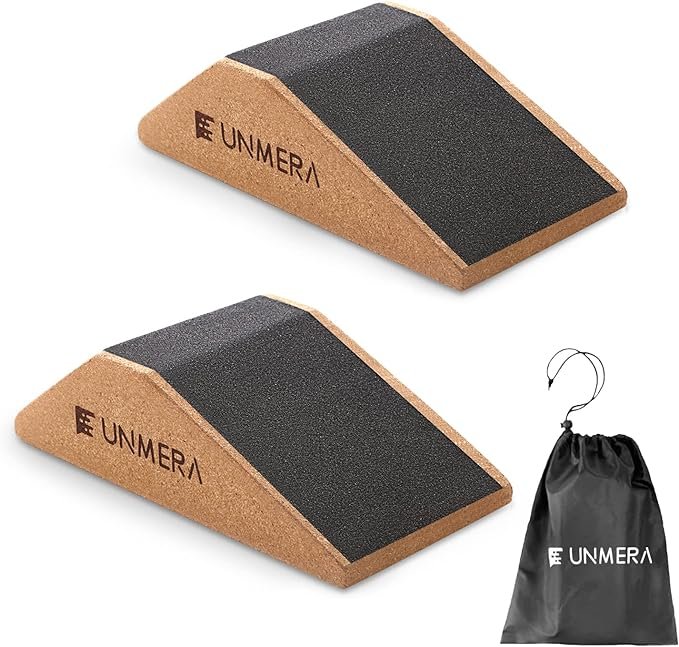
Welcome to HQ—starting from the big toe. Thanks to Kadour Ziani, our ATG Mobility Mentor. The guy’s 49 years old, the oldest and shortest known dunker. He taught us in person and gave us an eye-opening moment: we have weak and stiff big toes.
Success leaves clues, so it made sense to me—start with the big toe.
Big Toe to Calves: Progressive Stretching with Intent
It’s amazing how anyone who’s had knee issues usually also has tight calves and toes. We’ve noticed a strong correlation among people we train at HQ—those with flexibility problems are often dealing with deeper stiffness.
The great thing about the Professional Platform Elevated Weightlifting Slant Board is how scalable it is. Say you’re older and really tight—you can just put your toes there and start applying gentle pressure. As flexibility improves, you gradually start leaning back more.
I prefer to work through the big toe with intention, pain-free, and build pressure over time.
Addressing Calf Tightness with the Slant Board
Modern footwear often has oversized heel cushions—fashionable but not functional. This may contribute to tight calf muscles. The slant board seems to ease that tightness quickly.
We start on the first level. If you’re more flexible, push the hip forward and keep the knee locked out. I even use it for calf raises—building both flexibility and strength. And even if you’re just leaning forward into the slant, you’re actively engaging the calf muscles.
Posterior Chain Activation and Hamstring Flexibility
Slide out—first with bodyweight, then Fernando will show bar use. We’ve found that 9 out of 10 people can’t stand on a slant board with quads flexed and touch the floor. People are tight through the upper calf and hamstring, especially after knee surgery.
Again, the Professional Platform Elevated Weightlifting Slant Board allows you to gradually progress into these stretches. From foot strength to stability, everything activates.
The sequence alone—big toe, calves, hamstrings—is golden. It opens up the entire posterior chain.
Deep Hip and Internal Rotation Work
We continue the mobility flow into hips. From a 90/90 position, you’ll feel the outer hip. This is relaxing—you can check your phone while you sit and stretch.
For internal hip rotation, try to keep the big toe down. It’s advanced—Fernando’s into it, but I’m not there yet. Shoutout again to Kadour for this one.
Kids naturally have insane internal rotation. Adults should gently work into it—great for sports involving lateral motion. You want both external and internal hip rotation.
Couch Stretch and Butterfly for Daily Gains
Fernando sets up on the couch stretch, I go into the butterfly against a wall. The standard is knees down to the mat. You can even test strength by lifting with weights.
For me, squeezing glutes in the butterfly helps me get deeper into the stretch. Pushing chest and glutes toward the wall really activates the quads and lower abs.
Consistency with the couch stretch—especially post knee surgery—is life-changing. I have a partially artificial kneecap. The doctor said it would never bend like a normal knee. But here I am, practically in child-like mobility again.
King of Mobility: ATG Split Squat
We wrap up with the Ass to Grass Split Squat—our king of mobility exercises. I try to get the front hamstring to cover the calf without lifting the heel or touching the back knee. Started with elevation and assistance due to knee tears. Progressed through full range squats, backward sleds, and couch stretches.
Elevating the front foot and using support reduces required mobility and strength, making this scalable. It’s what I used to break through mobility plateaus—and even speed barriers.
Shoulders and Upper Body: Bonus Routine
We follow the lower body routine with four key shoulder exercises:
- External Rotation
- Pullover Stretch
- Trap 3 Raise
- Powell Raise
These build bulletproof shoulders—essential for athletes like quarterbacks, tennis players, and fighters. I used to have chronic shoulder pain; now I don’t skip these two: external rotation and pullover.
We don’t believe in shortcuts—just real work and smart tools like the Professional Platform Elevated Weightlifting Slant Board. Strength and mobility should be trained at the same time for the best athletic results.
Final Thoughts: Start Where You Are
Flexibility is the first thing the body loses—not hormones or muscle mass. Start now, be consistent. It takes time to build flexibility, but maintaining it is much easier.
I hope we treated you like you were right here with us in the gym. No fancy intros, no ad revenue—just pure value.
If you’re ready to train with us or want to try the Professional Platform Elevated Weightlifting Slant Board, we’re here to help. Thanks for watching and supporting ATG.
